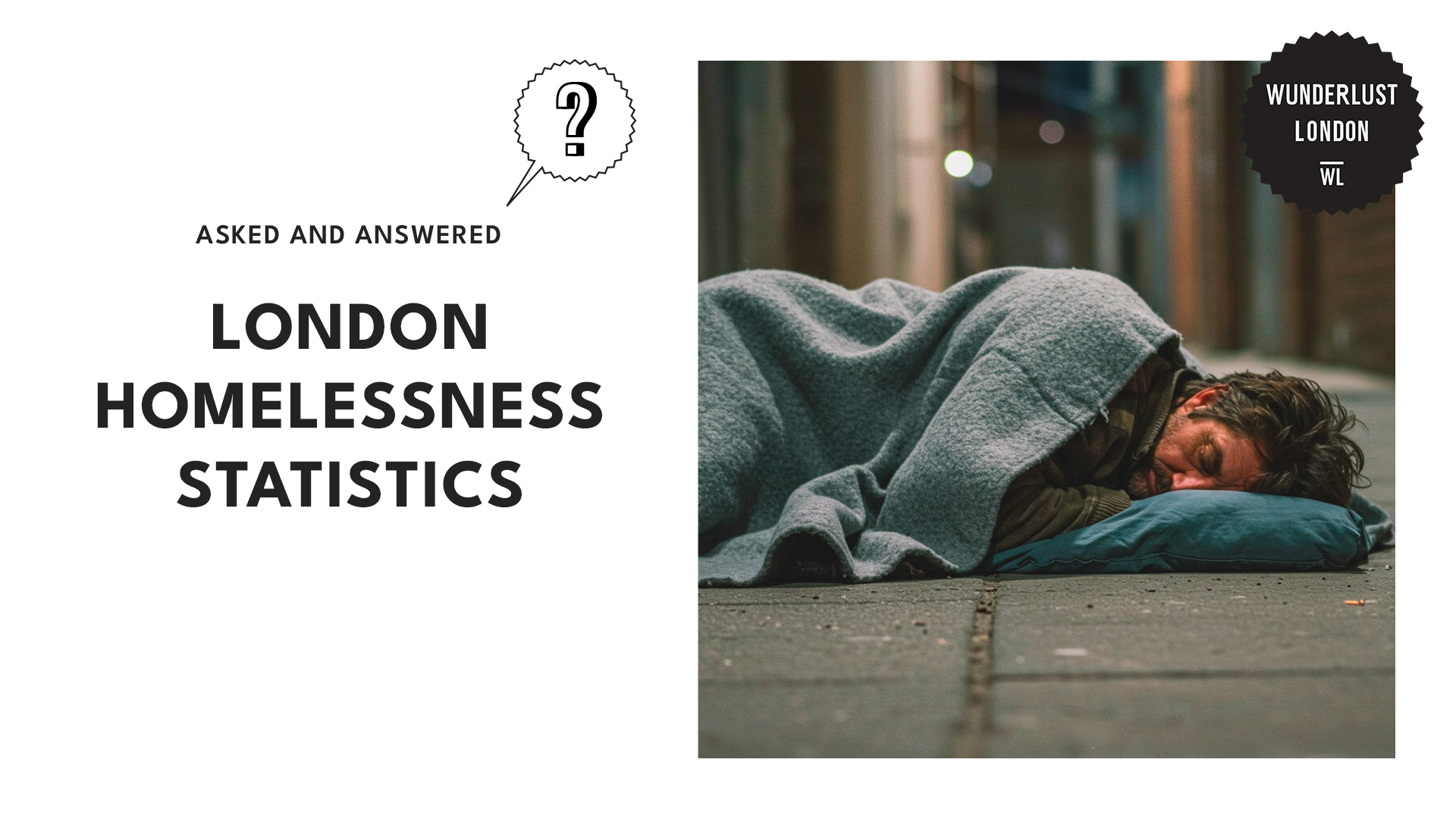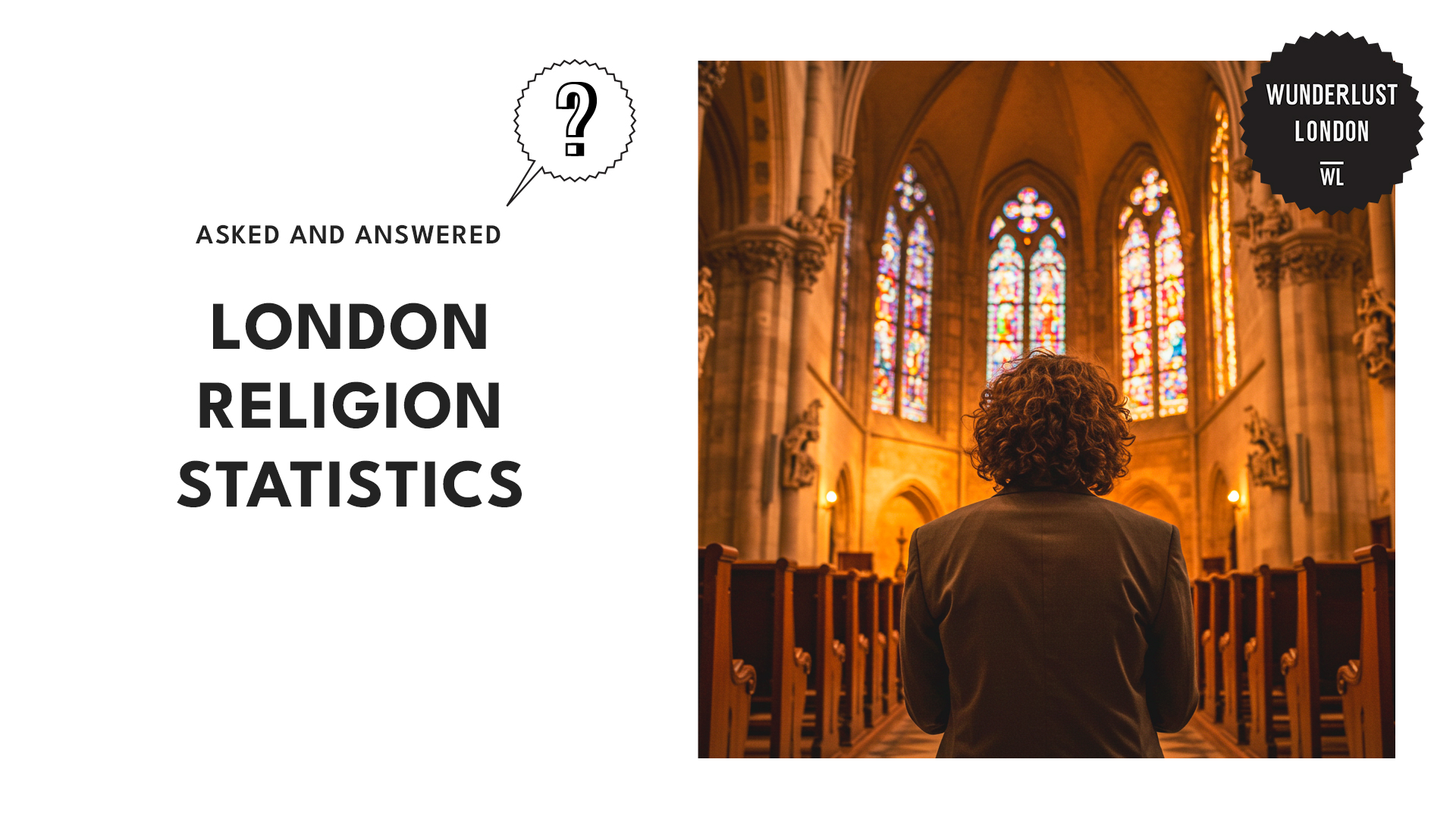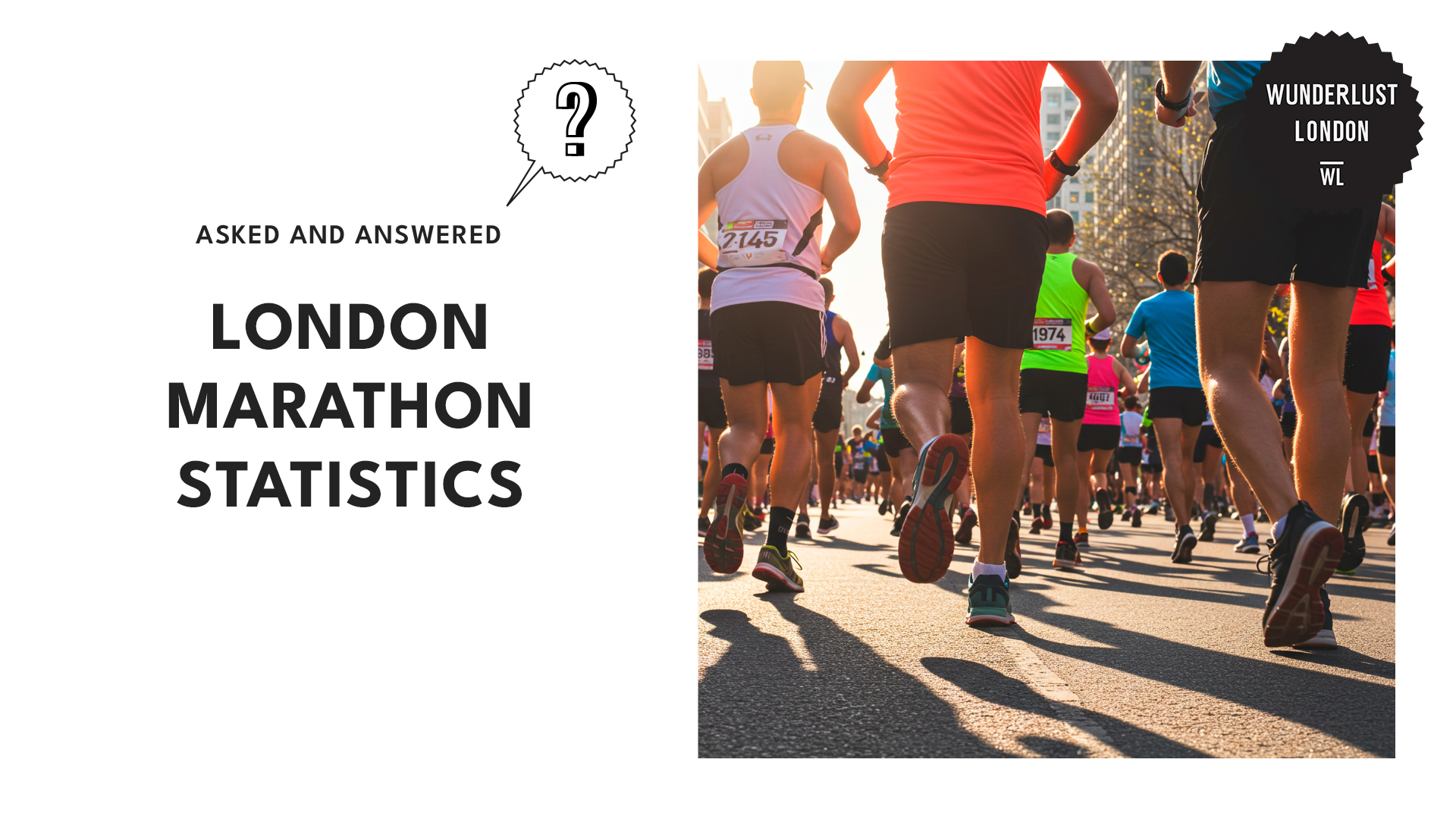Key Insights
- Between April 2023 and March 2024, the Combined Homelessness and Information Network (CHAIN) reported that 11,993 people were seen sleeping on the streets of London.
- London is facing a severe shortage of temporary accommodation due to insufficient rental properties available, according to the London Council.
- Centre for London shared that about 13% of households facing homelessness are due to the end of their rental contracts.
- 323,000 households in London are waiting for social housing, according to the Centre for London.
- Office for National Statistics data revealed that house and rent prices increased from 2016 to 2019, contributing to homelessness in London.
- London Councils reported that nearly 90,000 children were in temporary accommodations in March 2024.
- According to Trust for London, white individuals make up the largest ethnic group facing homelessness. There are also more males experiencing homelessness than females.
- Trust for London data revealed that Westminster has the highest number of homeless people among all London boroughs, with 2,102 people recorded in 2023/24.
- The Department for Levelling Up, Housing and Communities reported that London has the highest percentage (18%) of homeless households in the country.
- Mayor Sadiq Khan implemented the “Life Off the Streets” program to address the issue of homelessness in London.
Homelessness remains a serious and escalating issue in London.
According to the Combined Homelessness and Information Network (CHAIN), 11,993 people were seen sleeping on the streets of London between April 2023 and March 2024. This is a 19% increase from the previous year and 58% more than a decade ago.
To give you a clear perspective of how the crisis has evolved over past years, the following illustration shows the number of people seen rough sleeping in London from 2014 to 2024.
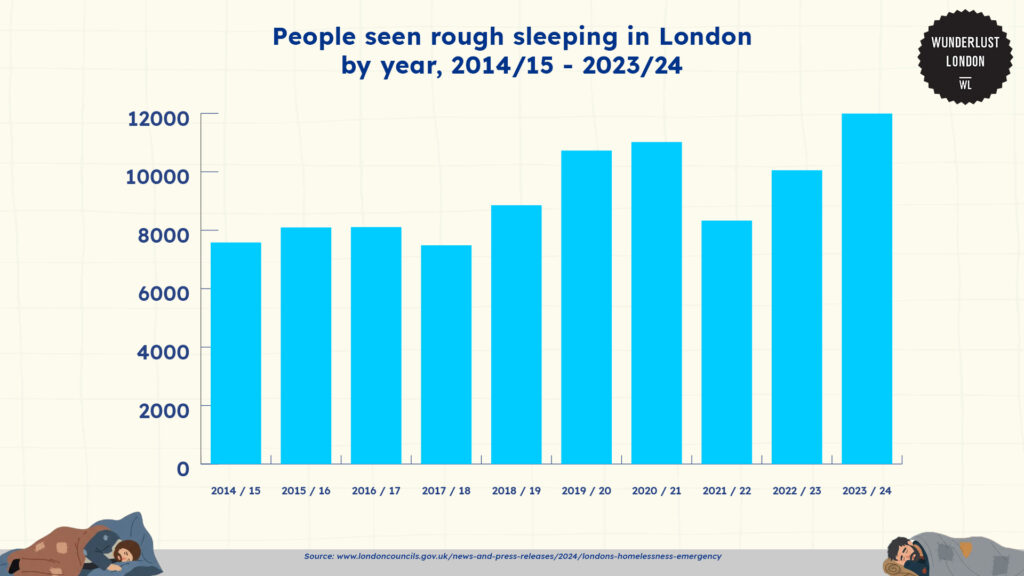
Rough sleeping has been rising almost every year over the past decade, except in 2017/18 and 2021/22.
The latest increase is the biggest jump in actual number ever recorded and the third-largest percentage rise in a decade.
On the other hand, the temporary drop in 2021/22 was likely due to extra resources during the COVID-19 pandemic, especially the government’s Everyone In initiative. This helped rough sleepers find housing.
However, once these emergency measures ended, homelessness surged again in 2022/23 and 2023/24.
Increase in B&B placements in London boroughs
A report from London Councils in October 2024 stated that London is facing a severe shortage of temporary accommodation (TA) because there aren’t enough rental properties available.
By early 2023, the number of rental homes was 41% lower than pre-pandemic levels. This makes it harder for London boroughs to find housing for homeless families.
Many landlords have stopped offering their properties for temporary accommodation, leading to the loss of over 10,000 properties between September 2022 and April 2024.
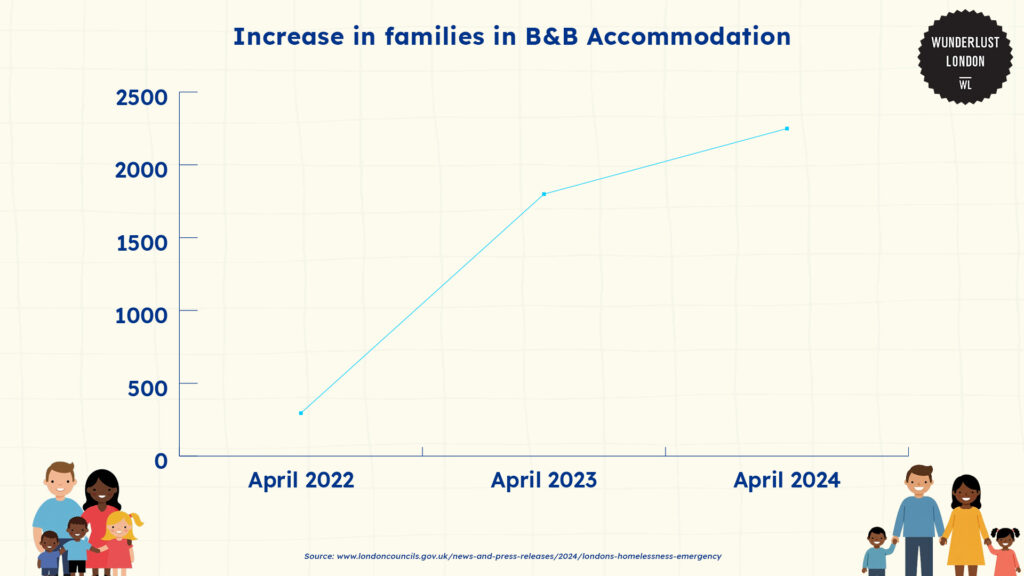
As a result, London Councils concluded that more families are being placed in Bed and Breakfast (B&Bs) accommodations. In April 2024, 2,249 families were living in B&Bs, which is a 662% rise from two years earlier.
Over 1,600 families had been stuck in B&Bs for more than six weeks—a 1,000% increase from April 2022.
Homelessness distribution across London boroughs
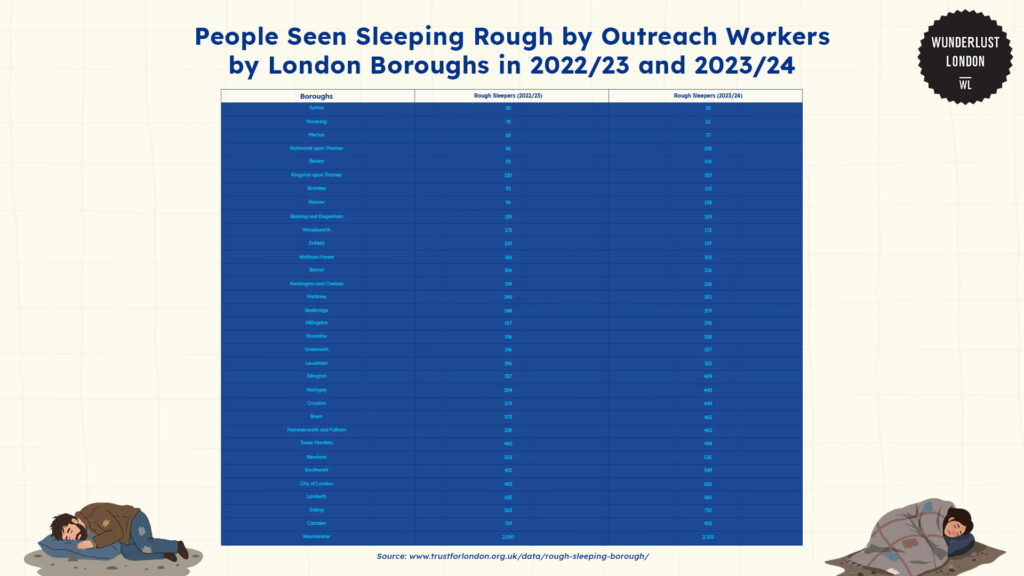
According to the data from the Trust for London, rough sleeping increased in nearly every borough in 2022/23 and 2023/24. Only five boroughs saw a decline: Sutton, Havering, Kingston upon Thames, Wandsworth, and Enfield.
Westminster also has the most rough sleepers, with 2,102 people recorded. This is more than double the number of Camden (903), the borough with the next highest number.
Some of the boroughs that have seen a dramatic increase in rough sleeping include Greenwich, which increased by 141 people, and Hounslow with 132 more people.
Generally, central boroughs have a higher number of rough sleepers than outer boroughs. This is likely due to a combination of factors, including access to services, visibility, and housing pressures.
London homelessness comparative analysis with other regions in England
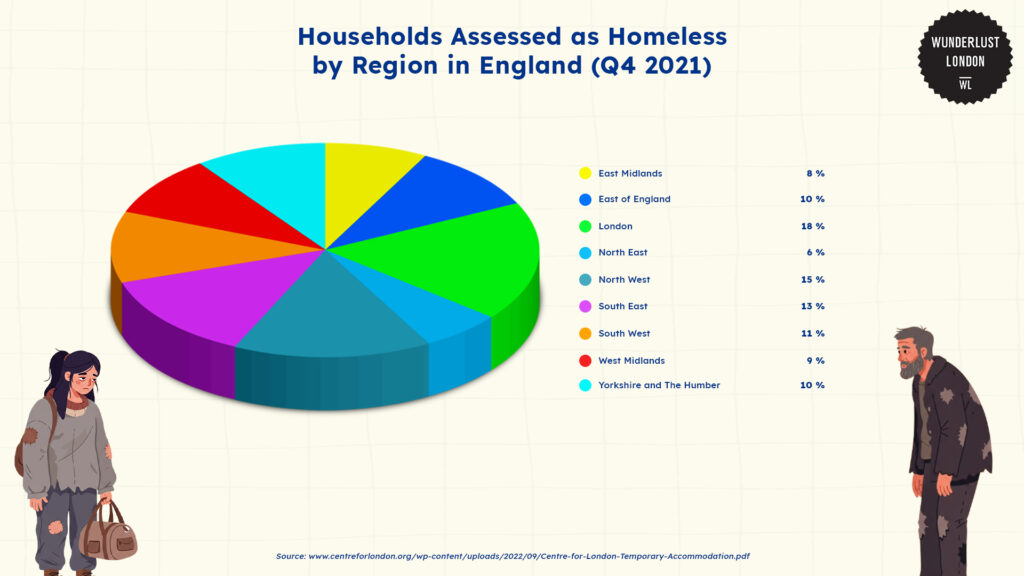
The Department for Levelling Up, Housing and Communities reported that London has the highest percentage of homeless households in the country at 18%. This figure is nearly one in five homeless households in the capital.
High housing costs, housing shortages, and population density likely contribute to this.
The North West (15%) and South East (13%) follow with significant shares. These areas also have large populations and high housing demand.
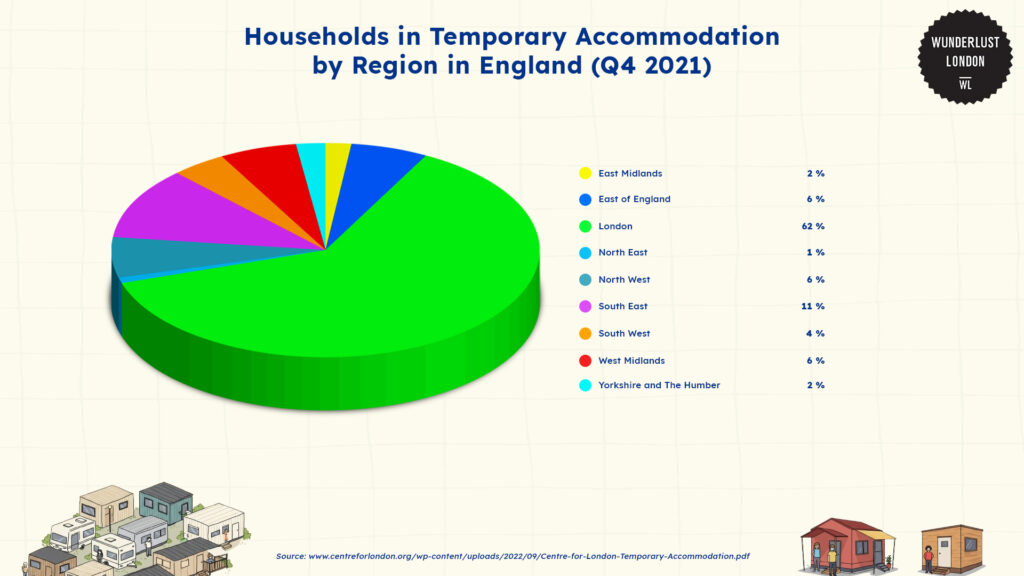
When it comes to the number of households in temporary accommodation across the country, the Department of Levelling Up, Housing and Communities recorded that London still contributes the largest share at 62%.
This highlights London’s heavy reliance on temporary housing solutions compared to other regions. High housing costs and shortages likely made it harder for people to find permanent housing, leading to prolonged stays in TA.
Other regions, like the North West and South East, follow similar trends. They rank high in both homelessness and TA use.
However, some regions, such as the East Midlands and Yorkshire and The Humber, have a higher percentage of homeless households (8-10%) but a lower share of TA use (2%).
This could mean that fewer temporary housing options are available in these regions, or people move elsewhere to access them.
Contributing factors to homelessness in London
According to the Centre for London, the main reason people lost their homes in the 1990s was falling behind on their mortgage payments, leading to repossessions.
Today, the most common reason is the end of a rental contract. This happens either because the landlord decides not to renew it or because the tenant receives a “no-fault eviction” notice.
Centre for London shared that about 13% of homeless households were in this situation.
Lack of social housing in London
Social housing is meant to be a more affordable option for people who can’t afford private rentals. But even if someone qualifies, getting a social home is a difficult process.
According to the UK Parliament, despite the rising rent prices, the share of social housing in England has dropped from 20% of all homes in 2000 to just 16% in 2023.
This means fewer homes are available for low-income people, making it even harder to find a stable place to live. The main reason for this decline is a lack of funding for new social housing. Due to this shortage, many people are stuck on long waiting lists.
Centre for London reported that over 323,000 households in London are waiting for social housing, more than twice the population of Cambridge.
Since 2017, the number has grown by 33%, with 81,000 more households added to the list.
Social housing waiting list by sub-region in London
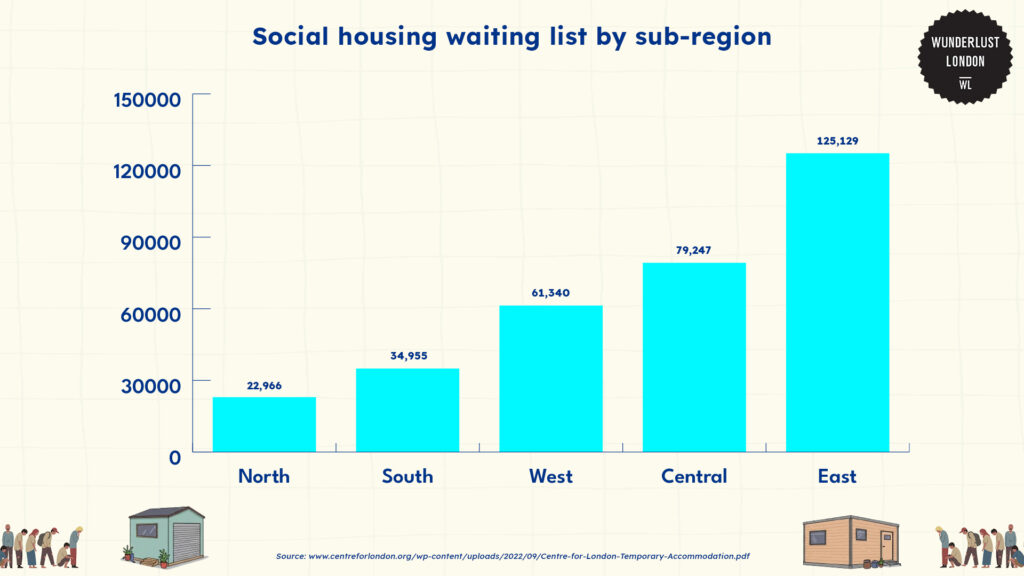
East London has the longest social housing waiting list at 125,129. It’s bigger than North, South, West, and Central London combined.
Centre for London also reports that there are insufficient large homes, so families have to wait a long time.
On average, a one-bedroom home takes about 2 years and 3 months (844 days) to get, while a four-bedroom or larger home can take over 6 years (2,304 days).
Rising rental costs in London
One of the biggest reasons people become homeless is the high cost of renting. Many people cannot afford to buy a home, so they turn to renting. However, even that is becoming too expensive.
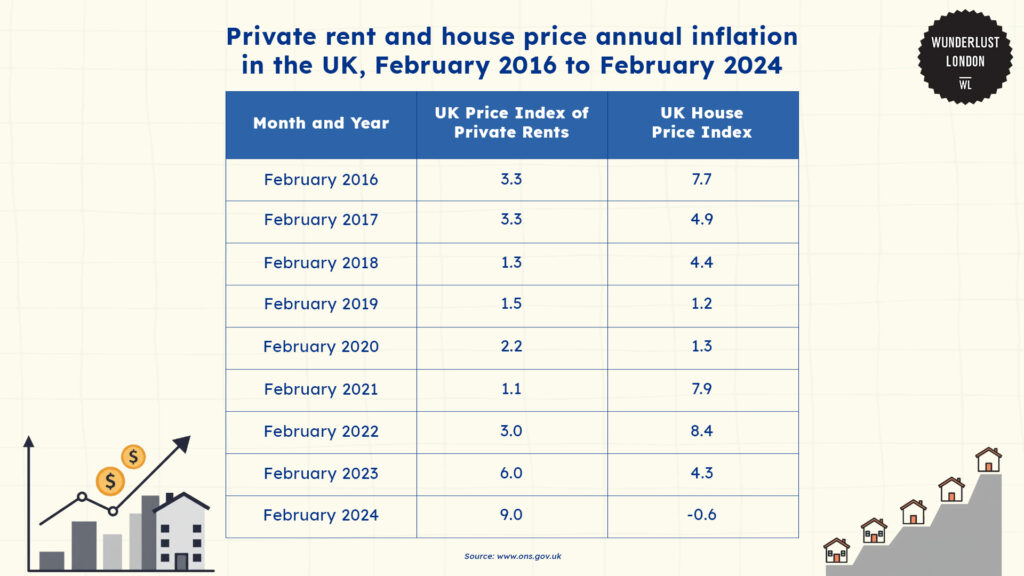
Data from the Office for National Statistics showed that from 2016 to 2019, house prices were increasing more than rents in the United Kingdom.
By 2019, both had slowed down. House prices rose just by 1.2%, while rent prices rose by 1.5%.
The biggest shift happened between February 2023 and 2024. Rent prices increased by 9.0%, the highest increase in years, while house prices dropped by 0.6%.
With rents rising so quickly, many people struggle to afford a place to live. Even though house prices are falling, high mortgage rates and strict lending rules make it tough for renters to buy a home.
Rising cost of living in London
With rent prices already high, the cost of living is making things even harder.
A survey conducted by the Office for National Statistics in January 2024 found that 41% of people who pay energy bills struggled to afford them.
The real problem is that while expenses for essentials like housing, food, and energy keep increasing, wages haven’t increased at the same rate.
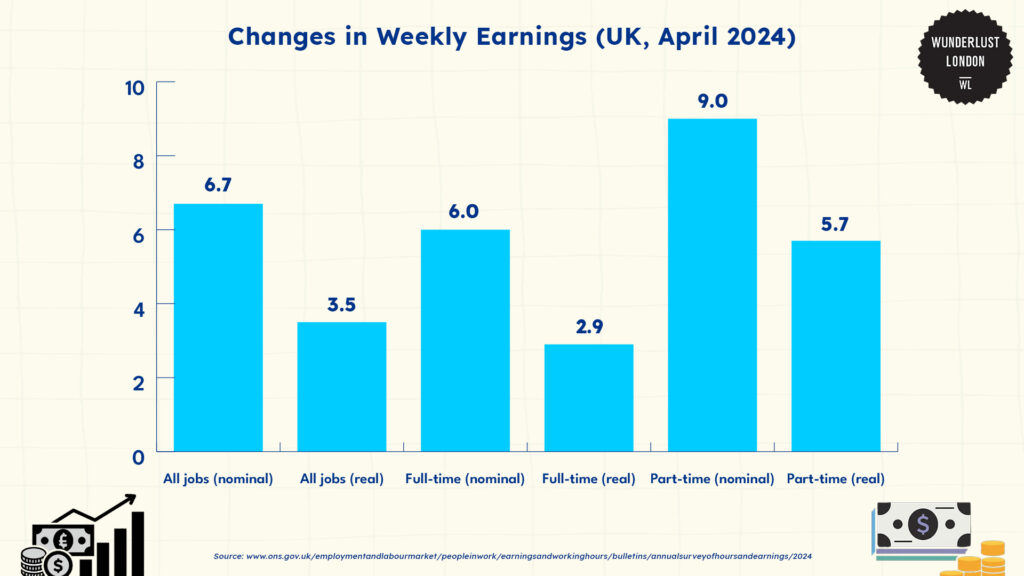
In April 2024, the Office for National Statistics shared that median hourly earnings for full-time employees increased by 6.4% compared to the previous year, showing some improvement.
However, inflation has eaten into these gains, making real wage growth lower than it seems.
By September 2024, the Office for National Statistics reported that wages had increased by 4.0% over the past year. However, this figure is slightly higher because of special one-time payments to the National Health Service (NHS) and civil workers in 2023.
Demographic analysis of homelessness in London
Homelessness demographics in London by age groups
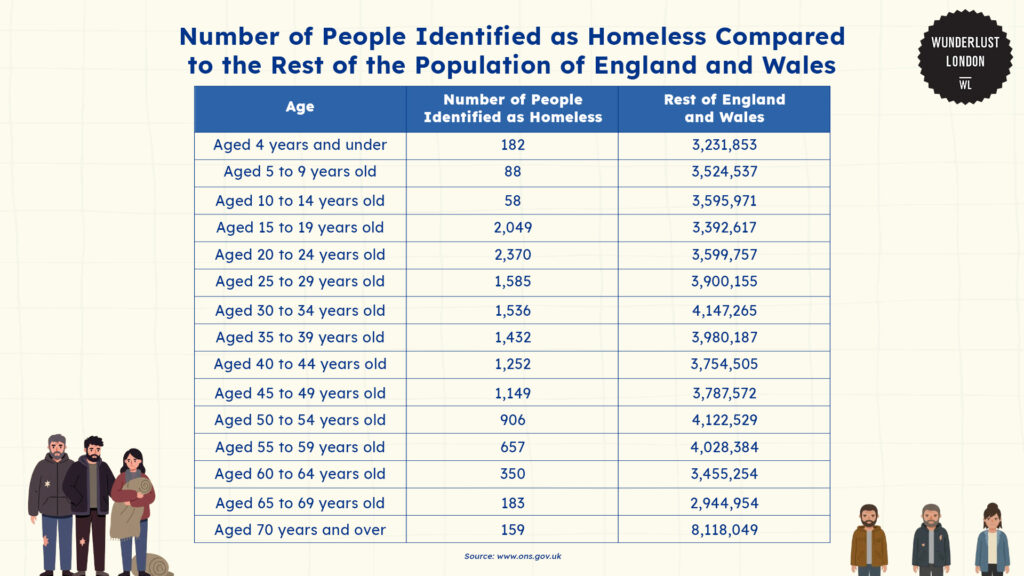
According to the Office for National Statistics data, the highest number of homeless people are in the age groups 15 to 19 (with 2,049) and 20 to 24 (with 2,370).
This suggests that young people may struggle with housing due to factors such as leaving home, financial instability, or a lack of family support.
After age 25, the number of homeless people gradually decreases with each age group. By age 50+, the numbers dropped significantly, with only 159 homeless individuals aged 70+.
This could indicate that older people have more housing stability, access to pensions, or social services.
Although they are lower in number, children are also affected by homelessness. There are 182 homeless children aged 4 and under. This suggests that some families experience rough sleeping. This could also mean that they live with families rather than being counted individually.
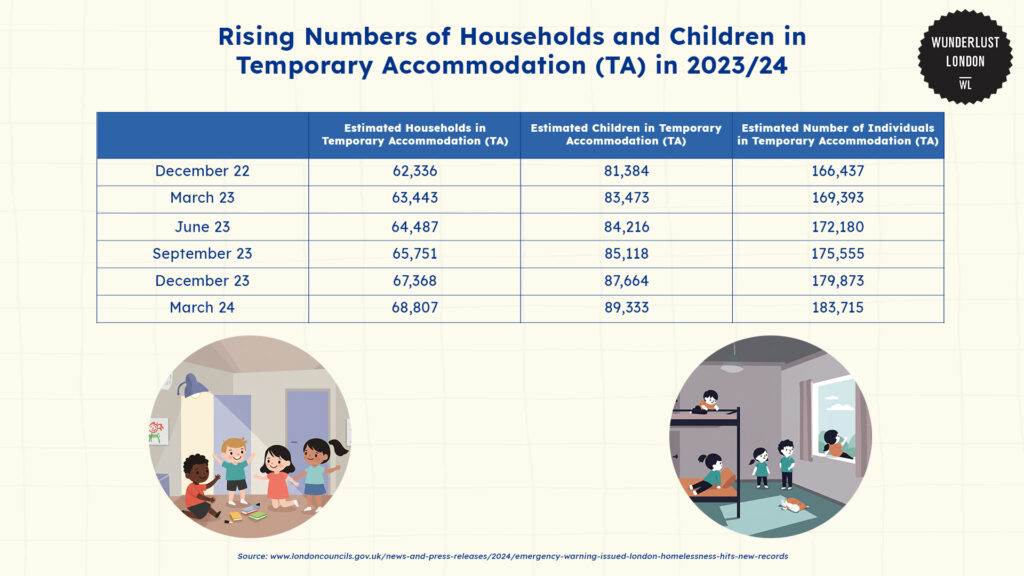
Additionally, London Councils reported that the number of children in temporary accommodation (TA) has seen a noticeable increase. It reached nearly 90,000 by March 2024. This figure is equivalent to one in every 21 children in the city.
Homelessness demographics in London by race and ethnicity
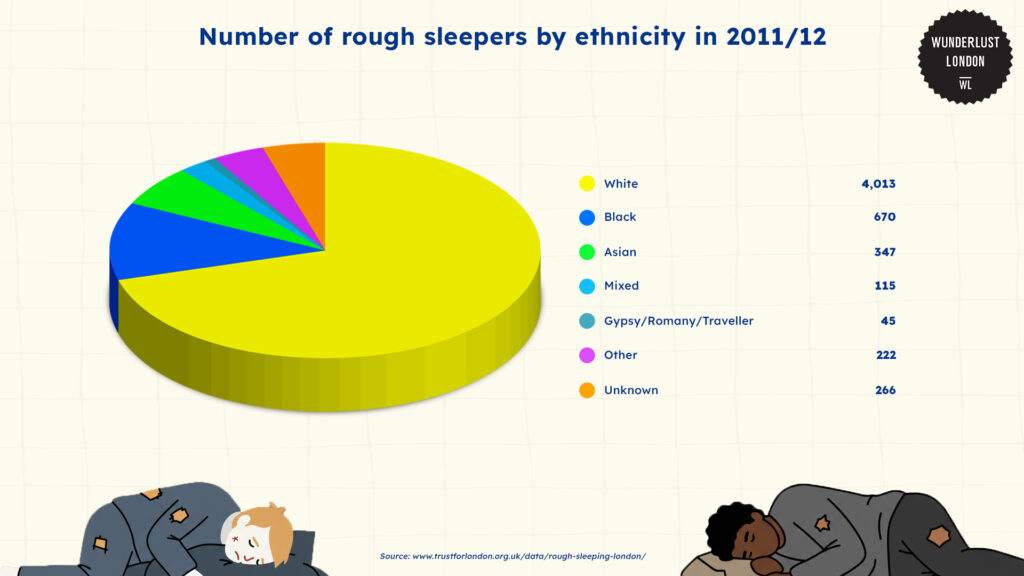
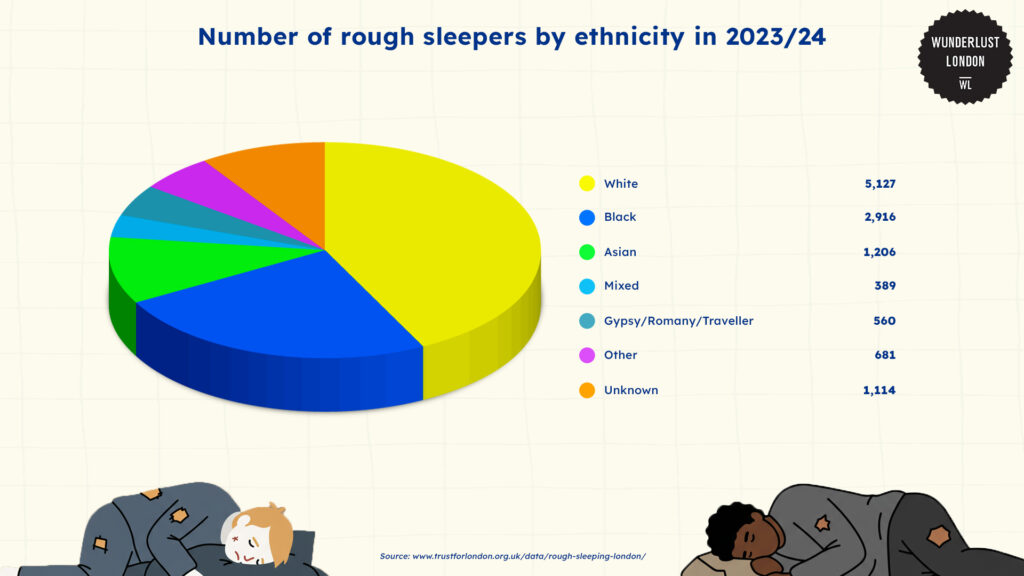
According to Trust for London, rough sleeping in London is becoming more diverse. While white people still make up the largest group, their share has dropped significantly from 2011/12 to 2023/24.
In 2023/24, more than half of rough sleepers are from minority ethnic backgrounds. The biggest increase has been among Black people, who now make up 25% of rough sleepers. It has increased from 15% ten years ago.
The shift suggests that homelessness is disproportionately affecting minority communities. Factors like systemic inequality, housing discrimination, and economic instability could be making it harder for these groups to find and keep stable housing.
Homelessness demographics in London by gender
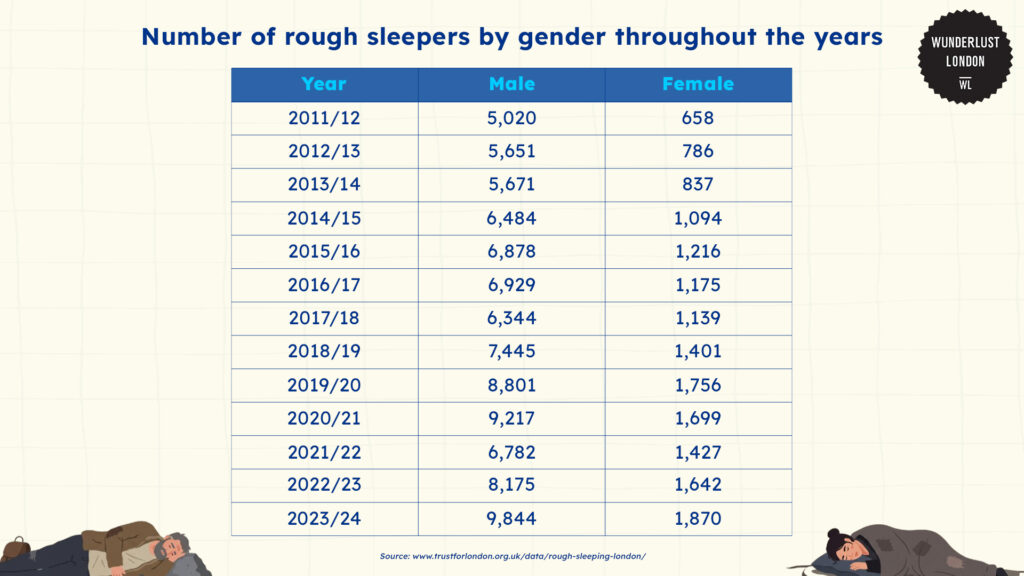
According to Trust for London, men make up the majority of rough sleepers in the city. However, the number of women experiencing homelessness has also grown.
Back in 2011/12, there were just over 5,000 homeless men and around 650 homeless women. In 2023/24, those numbers have nearly doubled, with almost 10,000 men and nearly 1,900 women affected.
The increasing number of homeless women is particularly concerning because they often face additional risks and vulnerabilities on the streets.
Policy measures by the London government to reduce homelessness
To address the rough sleeping in London, Mayor Sadiq Khan has implemented a comprehensive “Life Off the Streets” program. It focuses on both immediate support and long-term solutions for rough sleepers.
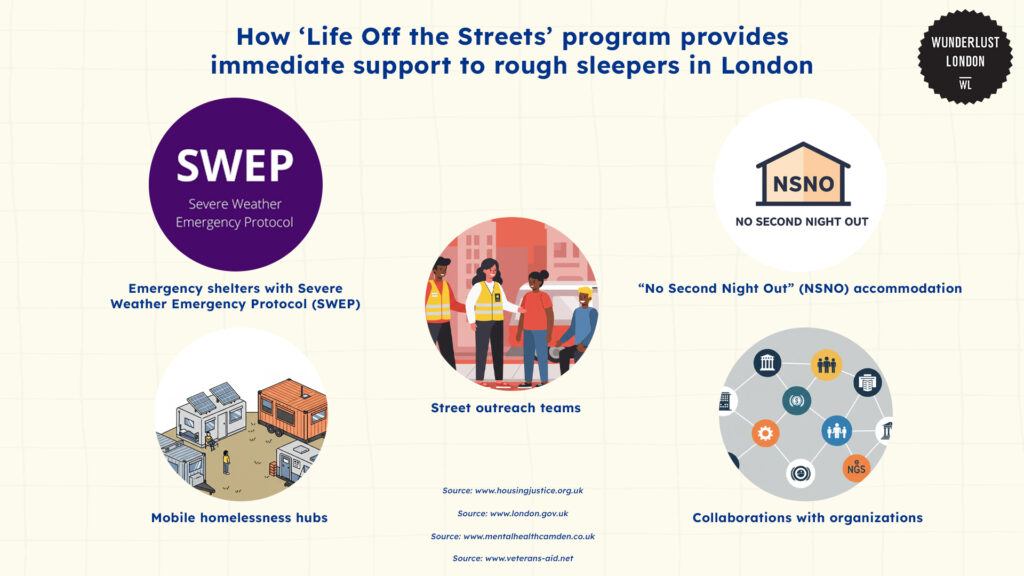
The Severe Weather Emergency Protocol (SWEP) ensures that emergency shelters open during extreme cold to protect rough sleepers from hypothermia and frostbite.
These shelters provide hot meals, warm clothing, and health services, coordinated by London boroughs and charities.
Mayor Khan also doubles his street outreach workers, including a rapid response unit, during winter to assist rough sleepers.
The “No Second Night Out” (NSNO) initiative offers emergency accommodation and tailored support plans to rough sleepers. This includes employment and mental health assistance.
There are also mobile homelessness hubs that provide food, hygiene facilities, and emergency shelter placements. These flexible units ensure rapid intervention in high-risk areas.
Additionally, the London government also collaborates with Veterans Aid to provide crisis housing, employment assistance, and mental health support for ex-military personnel at risk of homelessness.
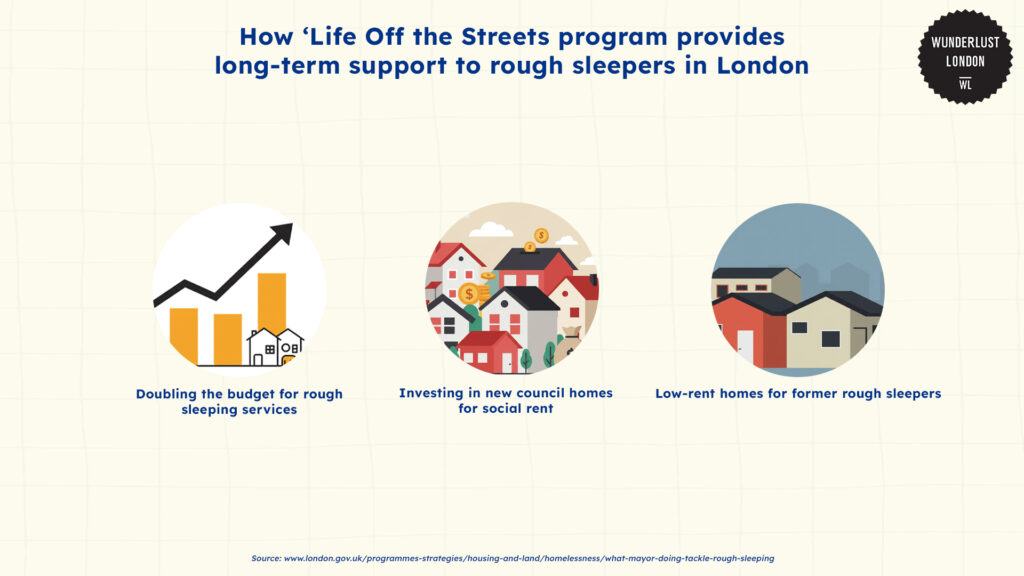
Beyond immediate interventions, the Life Off the Streets program also implemented long-term strategies to address homelessness in London.
The London government has doubled the budget for rough sleeping services to £18 million to support expanded street outreach teams, emergency accommodation, and specialised services.
£1 billion was also invested in 11,000 new council homes for social rent to tackle the housing crisis. This ensures affordable long-term accommodation for low-income individuals and families.
Lastly, the government also provided 3,700 low-rent homes for former rough sleepers. This is supported by the Mayor’s Tenancy Sustainment Teams, offering financial guidance, employment support, and mental health services to help maintain independent living.
References
- Bosetti, N., Urquijo, D., & Harding, C. (2022). Temporary Accommodation: London’s hidden homelessness crisis. Centre for London. https://www.centreforlondon.org/wp-content/uploads/2022/09/Centre-for-London-Temporary-Accommodation.pdf
- Combined Homelessness and Information Network. (2024). Rough sleeping in London (chain reports) – London datastore. https://data.london.gov.uk/dataset/chain-reports
- Cromarty, H., Greaves, F., Rankl, F., & Barton, C. (2024). Affordable housing in England. UK Parliament: House of Commons Library. https://commonslibrary.parliament.uk/affordable-housing-in-england/
- “Emergency” warning issued as London homelessness hits New Records. London Councils. (2024). https://www.londoncouncils.gov.uk/news-and-press-releases/2024/emergency-warning-issued-london-homelessness-hits-new-records
- How we operate. Veterans Aid. (2023). https://veterans-aid.net/how-we-operate/
- Office for National Statistics. (2024). Private rent and house prices, UK: March 2024. Private rent and house prices, UK – Office for National Statistics. https://www.ons.gov.uk/economy/inflationandpriceindices/bulletins/privaterentandhousepricesuk/march2024#:~:text=Average%20UK%20private%20rent%20increased,series%20began%20in%20January%202015.
- Office for National Statistics. (2024). Cost of living latest insights. Office for National Statistics. https://www.ons.gov.uk/economy/inflationandpriceindices/articles/costofliving/latestinsights
- Office for National Statistics. (2024). Average weekly earnings in Great Britain: September 2024. Office for National Statistics. https://www.ons.gov.uk/employmentandlabourmarket/peopleinwork/employmentandemployeetypes/bulletins/averageweeklyearningsingreatbritain/september2024
- Office for National Statistics. (2024). Employee earnings in the UK: 2024. Office for National Statistics. https://www.ons.gov.uk/employmentandlabourmarket/peopleinwork/earningsandworkinghours/bulletins/annualsurveyofhoursandearnings/2024
- People sleeping rough by London Boroughs. Trust for London. (2024). https://trustforlondon.org.uk/data/rough-sleeping-borough/#:~:text=What%20does%20it%20tell%20us,upon%20Thames%2C%20Enfield%20and%20Havering
- People sleeping rough. Trust for London. (2024). https://trustforlondon.org.uk/data/rough-sleeping-london/
- Reast, D., Anderson, R., & Townsend, K. (2024). London’s Social Housing Waiting Times. Centre for London. https://centreforlondon.org/publication/londons-social-housing-waiting-times/
- Severe weather emergency protocols (SWEP). Housing Justice. (2021). https://housingjustice.org.uk/night-shelters/our-resources/severe-weather-emergency-protocols-swep
- Streetlink’s no second night out. Mental Health Camden. (n.d.). https://mentalhealthcamden.co.uk/services/streetlinks-no-second-night-out#:~:text=No%20Second%20Night%20Out%20
- United Nations. (n.d.). Everyone included – how to end homelessness. United Nations. https://www.un.org/tr/desa/everyone-included-%E2%80%93-how-end-homelessness
- What the mayor is doing to tackle rough sleeping. London City Hall. (2024). https://www.london.gov.uk/programmes-strategies/housing-and-land/homelessness/what-mayor-doing-tackle-rough-sleeping
- Yap, R., & Trace, S. (2023). People experiencing homelessness, England and Wales: Census 2021. Office for National Statistics. https://www.ons.gov.uk/peoplepopulationandcommunity/housing/articles/peopleexperiencinghomelessnessenglandandwales/census2021#:~:text=People%20identified%20as%20homeless%20were,the%20rest%20of%20the%20population


